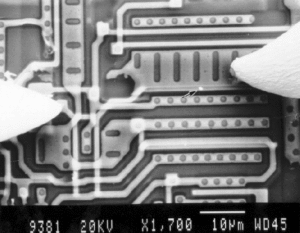Crack IC PIC16F715 Firmware
Crack IC PIC16F715 and decapsulate the microcontroller silicon package to have the center processor, flash and eeprom memory fully exposed, IC Firmware can be extracted from it after reset the MCU status;
Crack IC PIC16F715 and decapsulate the microcontroller silicon package to have the center processor, flash and eeprom memory fully exposed, Firmware can be extracted from it after reset the MCU status
PIC16C71X devices are supported by the complete line of Microchip Development tools. Please refer to Section 10.0 for more details about Microchip’s development tools.
A variety of frequency ranges and packaging options are available. Depending on application and production requirements, the proper device option can be selected using the information in the PIC16C71X Product Identification System section at the end of this data sheet after extract microcontroller pic16f887 file.
When placing orders, please use that page of the data sheet to specify the correct part number.
For the PIC16C71X family, there are two device “types” as indicated in the device number:
1. C, as in PIC16C71. These devices have EPROM type memory and operate over the standard voltage range.
2. LC, as in PIC16LC71. These devices have EPROM type memory and operate over an extended voltage range.
The UV erasable version, offered in CERDIP package is optimal for prototype development and pilot programs.
This version can be erased and reprogrammed to any of the oscillator modes.
Microchip’s PICSTART® Plus and PRO MATE® II programmers both support programming of the PIC16C71X for read mcu pic16c710 program.
One-Time-Programmable (OTP) Devices
The availability of OTP devices is especially useful for customers who need the flexibility for frequent code updates and small volume applications.
The OTP devices, packaged in plastic packages, permit the user to program them once. In addition to the program memory, the configuration bits must also be programmed.
Microchip offers a QTP Programming Service for factory production orders. This service is made available for users who choose not to program a medium to high quantity of units and whose code patterns have stabilized for the purpose of chip pic16f711 hex reading. The devices are identical to the OTP devices but with all EPROM locations and configuration options already programmed by the factory. Certain code and prototype verification procedures apply before production shipments are available. Please contact your local Microchip Technology sales office for more details.
Tags: crack ic protected archive,crack ic protected code,crack ic protected content,crack ic protected data,crack ic protected eeprom,crack ic protected file,crack ic protected firmware,crack ic protected information,crack ic protected memory,crack ic protected program


